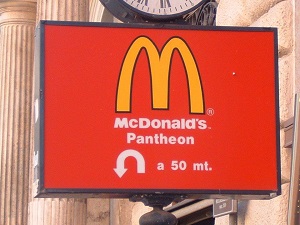By Lisanne Cheizoo
Staff Writer
The semester has started, and for most of us it is time to leave our lovely home-cooked meals behind and start cooking for ourselves again. Cooking is always a challenge because not only do we want to have cheap food, it also has to be easy to make and within a reasonable amount of time. Over the summer, I decided to add extra requirements to this: healthy and reliable.
Last semester in Human Geography class, we discussed food and food-processes around the world. During one of these lectures, it was stated that because of globalization we now have access to food from all over the world. Especially fast food thrives on the process of globalization, and not without reason: Not only is it fast, it is also an easy cheap option and, no matter where you are, you always know what you get. Whether you are in Japan, South Africa or Romania: a Big Mac menu is a Big Mac menu. Although, this appears to be a good thing (as we do not have to do without our regular Dominos pizza) it has its inconveniences as well.
First and foremost: Fast food is unhealthy. Hamburgers, fries and chicken wings contain large quantities of saturated fat, which raises cholesterol levels in your blood. This does not only lead to an increased weight gain, but also enhances your chances of getting heart- and vascular diseases. With more people becoming overweight or obese every year, fast food chains are turning into public enemy #1. The food they produce is far from healthy and people should be made aware of these risks. What I would like to draw your attention to, however, is a (fairly) new initiative that has been gaining ground over the past few years: Its name? Slow food.
The Slow Food movement started in the mid 1980s in Italy as a counter movement to the growing number of fast food chains in the country. This movement gained a lot of support from chefs all over the country, following the opening of a McDonalds in Piazza del Spagna in Rome. These chefs combined forces to preserve original Italian kitchen and all of its traditions.
As another negative effect of fast food: all of the small, traditional restaurants simply cannot afford to offer low prices, since they do not mass-produce. These restaurants serve traditional cuisine and make sure every ingredient used is fresh. In the end, a wonderful meal, which is not gobbled up in 15 minutes, but actually takes time to appreciate, to taste, and to eat, is presented.
Is this not what eating, cooking and having dinner is all about? Is it not a way of sharing thoughts, being together and having fun? Is it not part of our culture? With the rise of these fast food restaurants, a part of our culture is being erased. Is this really what we really want?
I do not. That is for sure. Even though being a student makes this hard, I try to restrain myself from eating fast food. Every once in a while fries is fine, but when in Rome I want to eat a traditional pizza, lasagna or tiramisu. Not a McFlurry or a Frappuchino.
What we eat is part of our culture, something we can share. If we continue to give in to fast food chains, these culturally rich, foreign cuisines may just disappear. And no one is waiting for a global kitchen that consists of hamburgers and fries. We as UCR students are lucky enough to have an international community, so why not learn from each other? Try making a Peruvian dish, or something from Thailand, or visiting the local market on Thursday. Not only is it healthy, but it also contributes to this world’s rich and varied cuisine. Food plays a central role in human interaction and culture. Let us keep it that way.
Lisanne Cheizoo, class of 2015, is a Literature and Theatre & Media Studies major from Uden, the Netherlands.


Dear Jeeby,
Thank you for your comment on this article. I agree with you that I forgot to add an important point: a clear reason why slow food is good. An explanation of how you can support local cuisines by joining this movement (plus many other advantages), would have been appropriate. However, the reason why I didn’t include more detailed information about the Italian cuisine, is because this isn’t the main focus of this article. Creating awareness of what Fast Food does to the cultural dimension of our eating habits, is. That’s why I chose to focus more on the cultural dimension to eating habits instead of the Italian cuisine.
I hope this explanation has helped.
Lisanne
So much is missing in this article. nothing is explained about proper italian slow-food (that its’ about 7-9 courses long, takes 3-4 hours involves so many different ingredients, styles and foods). It’s nice and all to have some words on why fastfood is shit. but then also explain why slow-food is good (aside from: it’s healthier than Mcdonalds). The article is nice, but it is not finished.